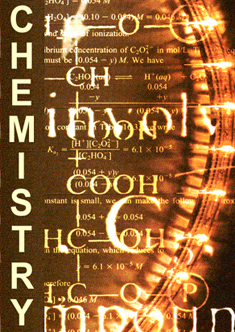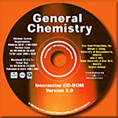| Lecture |
|
1 |
States
of Matter
• Derived Quantities and Scientific Notations
and SI units
• The atom in physics and chemistry
• The periodic table and states of matter
• Definite particles of a matter and atomic mass
• Properties of gases, liquids and solids
• Boyles’s Law, Gay-Lussac’s Law; General
and Ideal Gas Laws
• Avogardro’s Principle
• Dalton’s law of Partial Pressures
• Homogenous and heterogeneous mixtures (colloids)
• Physical and chemical changes
• States of matter: solids, liquids and gases
• Chemical Formulae
• The mole and Avogardro’s Law
• Calculation of moles, molarity, molality, normality,
ppm, %, mole fractions and equivalents
• Osmosis and osmotic pressure |
2 |
Atomic Theory and
Electronic Structure
• Subatomic particles: Historical overview
• Atomic numbers, mass numbers and atomic weight
• Isotopes
• Bohr’s Planetary Model of the atom
• Heisenberg Uncertainty Principle
• Electron energy states - Energy levels/shells
• Quantum mechanics: Schrodinger Equation
• Electron orbitals and Pauli’s Exclusion
Principle
• Aufbau Principle and Hund’s Rule
• Quantum mechanics and the Periodic Table |
3 |
Electron Configurations
and the Periodic Table
• Electron Orbitals
• Recap: Bohr: Electrons allowed energy states;
Pauli Exclusion Principle.
• Aufbau Principle and Hund’s Rule
• Periodic Table: Periodicity, chemical family,
valence electrons & Octet Rule
• Electronegativity, physical properties, atomic
radius, first ionization energy, electron affinity,
• Electron configurations of cations and anions
• Elements for life |
4 |
Chemical Bonds
• How atoms form molecules
• Types of chemical bond
• Ionization energies: Transferring and sharing
of electrons
• Ionic bonds: Structure and formation compound
• Covalent bonds formation: Valence bond theory,
Noble Gas configuration, Molecular orbits, Covalence number,
Sigma and Pi bonds, Lewis structures and Valence electrons.
• Formation of polar covalent bonds (molecular polarity)
• Electron Sharing - hybrid orbitals
• Electron dot structures
• Polar versus non-polar covalent bonds
• Metallic and coordinate bonds
• Crystals |
5 |
Electronegativity
and Inductive Effects
• Bond formation and electronegativity
• Polar covalent bond formation
• Dipole moment and bonds
• Molecular polarity and inductive effects
• Resonance structures and effects
• Intermolecular forces: Dipole-dipole interactions;
Hydrogen bonds; Van De Waals (London) forces.
• Intermolecular forces: Boiling points and Solubility
• Shape of molecules and VSEPR Theory
• Bond angles and dot structures
• Infrared Spectroscopy |
6 |
Chemical Equations
• Writing balanced chemical equations
• Types of chemical equation will be discussed including:
synthesis; decomposition; substitution; hydrolysis; combustion;
neutralization; precipitation; hydrogenation; photosynthesis
• Stoichiometry and mass relationships
• Limiting reactions (reactants)
• Percentage yield |
7 |
Energetics, Equilibrium
and Kinetics
• Chemical equilibrium and the types of
systems
• Reaction types: Exothermic and Endothermic reactions
(Industrial applications)
• Le Chatelier’s principle
• Comparison between open & isolated systems
• Effect of Temperature, Pressure, Volume and Concentration
• Effect of catalyst
• Optimization of reaction rate
• Chemical equilibrium and Equilibrium Constant
(Keq)
• Concentrations at equilibrium
• Industrial production of ammonia and sulfur trioxide
• Heterogeneous equilibrium
• Biochemical Reactions (glycogen synthesis, tooth
decay, blood gas transport
• Enzyme catalysis |
8 |
Reaction Rates
• Rates of reaction and factors affecting
rates of reactions: Collision theory, activation energy,
• Catalyzed reactions
• Zero and Second Order reactions
• Reaction mechanism
• Rate laws of elementary reactions
• Rate determining step |
9 |
Solubility and Partition
• Solubility rules
• Soluble and insoluble salts
• Writing precipitation reaction equations
• Heterogeneous equilibria and precipitation
• Solubility Product Constant and Ion Products
• Common ion effects
• Saturation and Molar solubilities
• Partition (distribution) coefficient and Fractions
• Biochemical extraction
• Partition: Acids and bases
• Industrial application of partition
• Calculation exercises |
10 |
Ionic Equations
• Writing ionic formula
• Common ions
• Balancing and naming ionic compounds
• Ionic compounds containing: elements; and polyatomic
ions
• Writing precipitation reactions (molecular, ionic,
net ionic equations
• Formation of kidney stones |
11 |
Acids and Bases
• Definitions and common acids and bases
• Bronsted-Lowry Acids and Bases
• Lewis acids
• pH and calculation of
• pH: Concentration of H and OH
• Ionization, dissociation and ion product of water,
Kw
• Conjugate acid and base pairs
• Acid-base equilibria
• pH, strong acid and strong bases
• Organic compounds that are acids and bases (Resonance
structures)
• Common Acid-Base Indicators
• Acid- Base Properties of Salts
• Salts that produce neutral, basic and acidic solutions
• Calculations |
12 |
Chemical Analysis
and Titrations
• Chemical analysis and titrations
• Indicators
• Titrations: Primary (1o) and Secondary standards
• Chemical equilibrium and Equilibrium Constant
(Keq)
• Concentrations at equilibrium
• Titrations involving: strong and weak acids and
bases
• Ka & Kb (Relationship), pH, pOH, pKw, pKa
and pKb
• Buffer solutions
• Henderson-Hasselbach Equation: derivation
• Weak acid (Ka) and weak base (Kb) ionization Constants)
• Calculations of acid-base reactions |
13 |
Gas Laws, Phases
& Chemical Potentials
• Daltons law
• Partial pressure of gases and mole fraction
• Ideal gases
• Avogardro’s Law and molar volume
• Boyles Law, Charles Law
• Gas laws and Ideal Gas Equation
• Phase diagram
• Freeze drying and distillation
• Real gases and effect of departures from ideality
• Homogenous and heterogeneous equilibria
• Phase rule
• Extensive and intensive (colligative) properties:
• Evaporation and vapour pressure
• Raoult’s Law
• Chemical potential, diffusion and stoichiometry |
14 |
Oxidation and Reduction
• Oxidation and reduction agents: Redox
reactions
• Oxidation number rules and balancing redox equations
• Electrode potentials: Standard hydrogen electrode
• Standard electrode and redox potentials
• Standard Cell Potential Ecell
• Reaction Prediction from standard cell potentials
• Electrolysis, F=L?
• Oxidation and Reduction - Life Science
• Respiration and anaerobic respiration
• Splitting redox reactions and standardized half-reactions
• Free energy and standard reduction
• Redox and non standard conditions |
15 |
Thermodynamics
• Introduction: Count Rumford, Joule, etc.
• First law of thermodynamics
• Internal energy (Potential and Kinetic Energy)
• Heat calculations and specific heat capacities
• Activation energy
• Enthalpy, Enthalpy of formation and dissociations
with calculations
• Hess’s Law
• Second Law of Thermodynamics: Entropy
• Gibbs Free Energy
• Reaction isotherm equation
• Van’t Hoff Equation (Reaction Isochore) |
16 |
Isotopes Radioactivity
• Radioactivity and nuclear definitions
• Transformation Series
• Radioactive Isotopes and their half-life
• Nuclear equations for alpha, beta and gamma radiation
• Balancing nuclear reactions and decay series
• Nuclear Fission and energy of nuclear fission
• Transmutation and fission
• Separation of isotopes
• Ionizing radiation and nuclear energy
• Free radicals and the effects of radiation
• Nuclear fusion, mass defect and energy
• Nuclear bombs and the scientists
• Fundamental particles of matter
• Effects of radiation and protection
• Inverse square law and background radiation
• Units of radiation and older units of radiation
• Absorbed Dose and dose equivalent
• Energy of gamma- or X-rays and
• Measuring of ionizing radiation
• Radiation in the food industry and life sciences
• Biological application – advantages and
disadvantages
• Medical Diagnosis and Therapy: Radionuclides usage.
• Types of Radiation Therapy
• CT Scanner, MRI scan and PET-scan |
17 |
Review of Structure
and Bonding
• Bonds:
Covalent (single and multiple)
• Lewis dot structure and determination of charge
• Exceptions to octet rule
• Electron pushing
• Resonance contributors
• Shapes of molecules (VSEPR)
• Polarity of organic molecules
• Valence bond (hybridization and molecular orbital
theory)
• Reaction mechanisms |
18 |
Organic chemistry
• Nomenclature (IUPAC)
• Hydrocarbons (saturated and unsaturated): Alkanes,
alkenes and Alkynes
• Non-halogenated and halogenated
• Organic compounds: Formulae and naming
• Functional groups, properties and chemical reactions
of: alcohols; aldehydes; ketones; carboxylic acids; ethers;
esters; organo-phosphate esters; amines; amides; thiols
(mercaptans); and aromatic compounds.
• Standard organic reactions: Homolytic and Heterolytic
fission, Nucleophilic and Electrophilic reactions, Free-radical
substitution, electrophilic addition and substitution,
nucleophilic substitution and addition reactions; oxidation;
reduction; and hydrolysis |
19 |
Hydrocarbons
• Properties of alkanes and alkenes
• Covalent bond fission (hemolytic and heterolytic
fission)
• Carbonium ion structure and properties
• Nucleophilic substitution and elimination reactions
• Nomenclature of alkanes, alkenes and cyclic hydrocarbons
• Alkanes and cycloalkanes
• Alkyl-groups
• Groups of organic compounds
• Reactions of the alkanes – oxidation and
halogenation
• Unsaturated alkanes: Alkenes and Bonding
• Reactions of Alkenes
• Cycloalkanes and cycloalkenes
• Generation of racemate mixtures
• SN1 and SN2, E1 and E2 mechanisms
• Hydrogenation and halogenation reactions |
20 |
Isomers
• Stereochemistry: Structural isomerism
(skeletal, functional and positional)
• Geometrical isomers: Cis and trans isomers
• Conformation isomers and Newman projection (boat
and chair isomers)
• Optical isomers: Enantiomers: Properties of Enantiomers
• Nomenclature: The sequence rule
• Fischer projection (S and R forms)
• Molecules with two chiral centres (diastereomers)
• Physical properties of isomers
• Exercises
|
21 |
Reaction Mechanisms
• SN1 and SN2
• Effects of solvents
• Nucleophiles and electrophiles
• Elimination reactions (E1 and E2)
• Saytzev’s rule
• Predicting preferred pathways |


